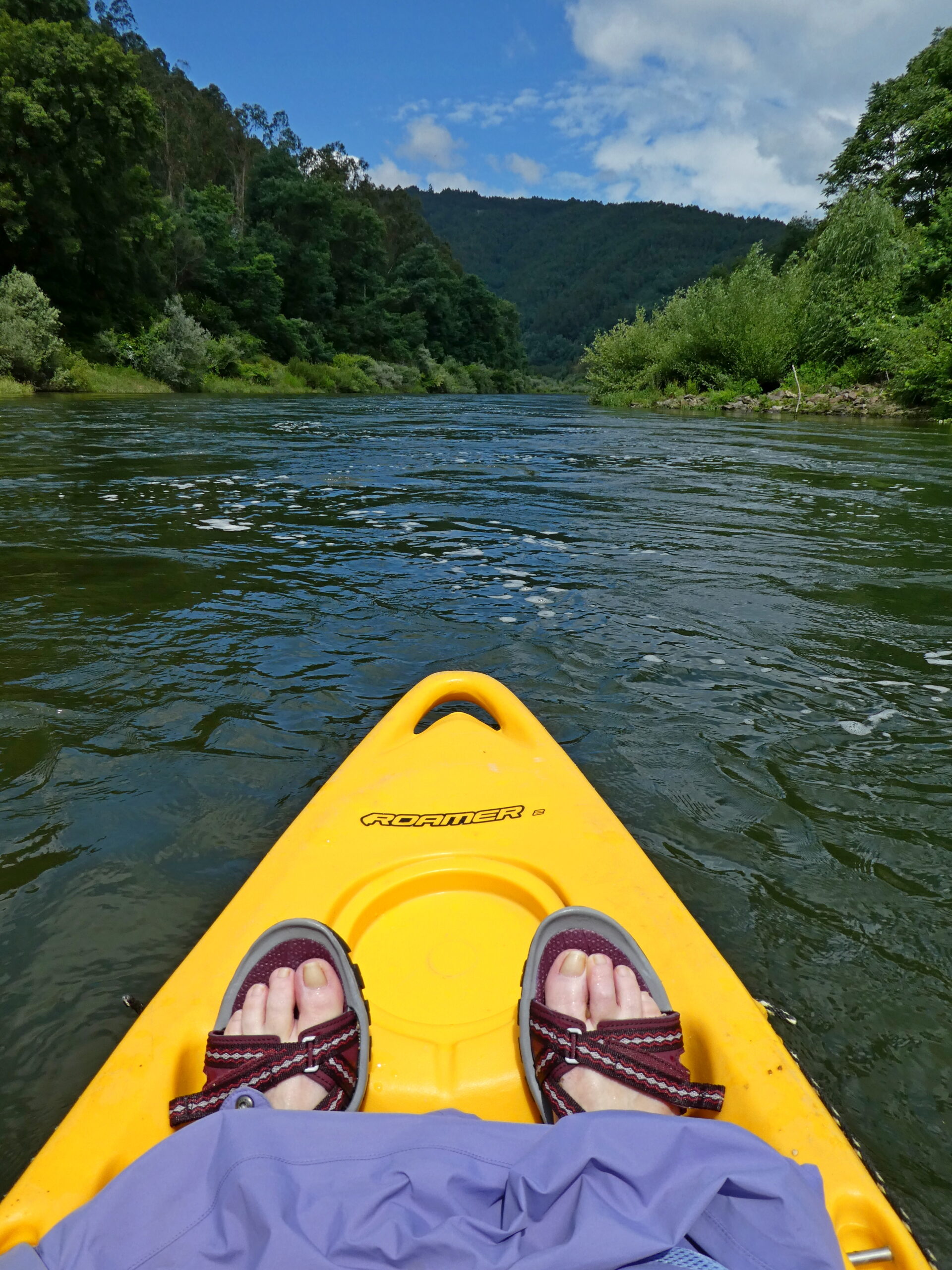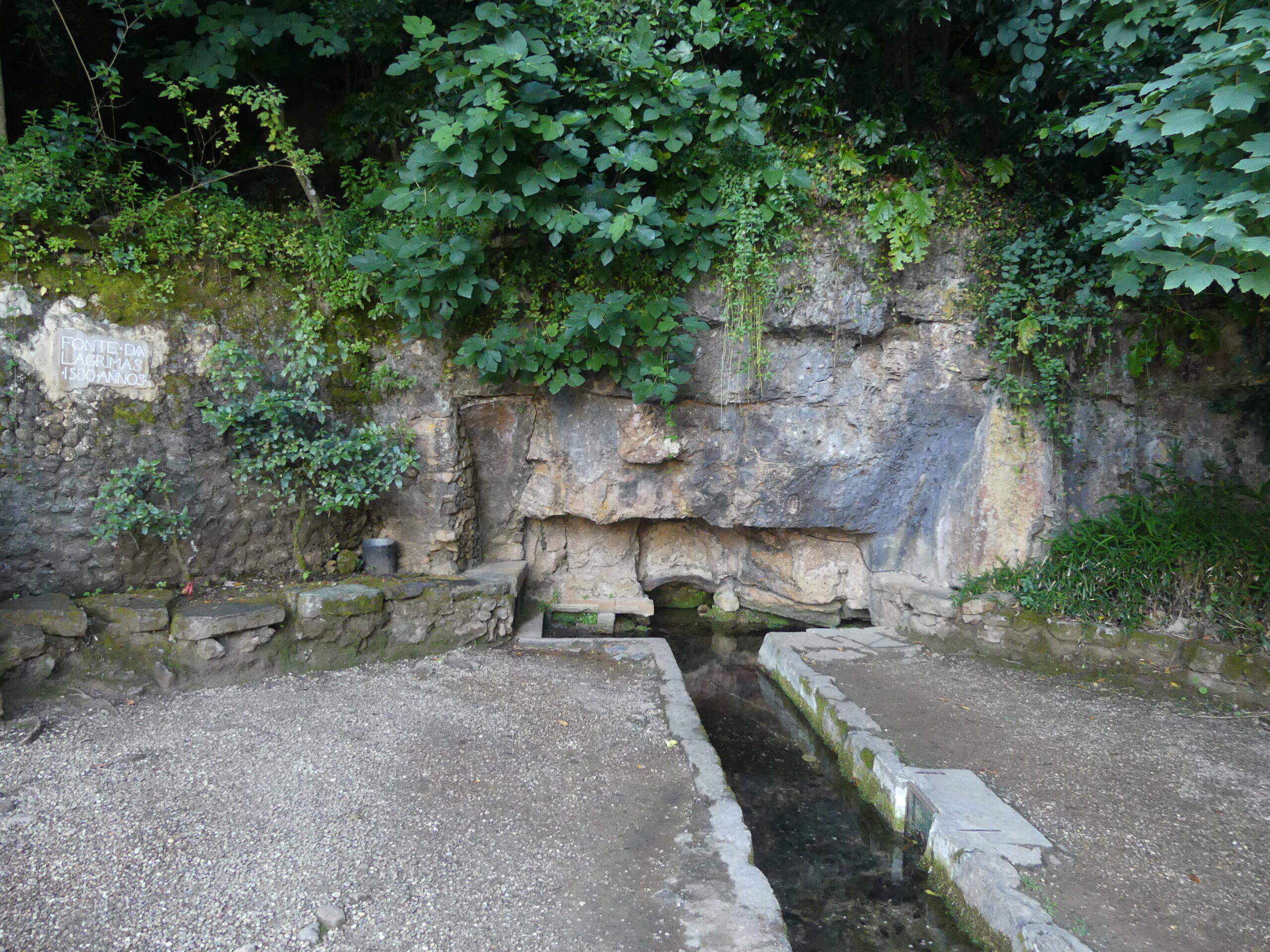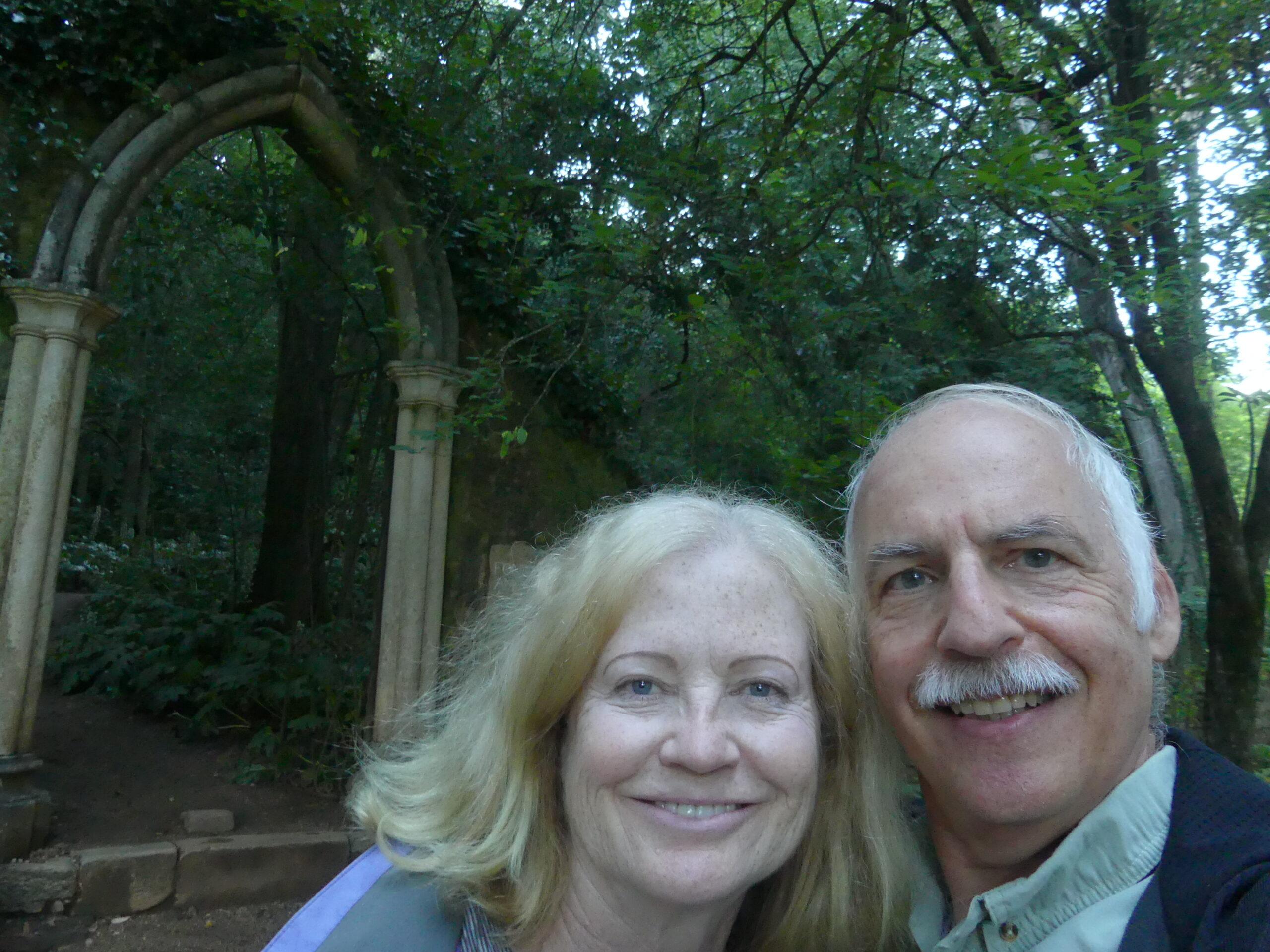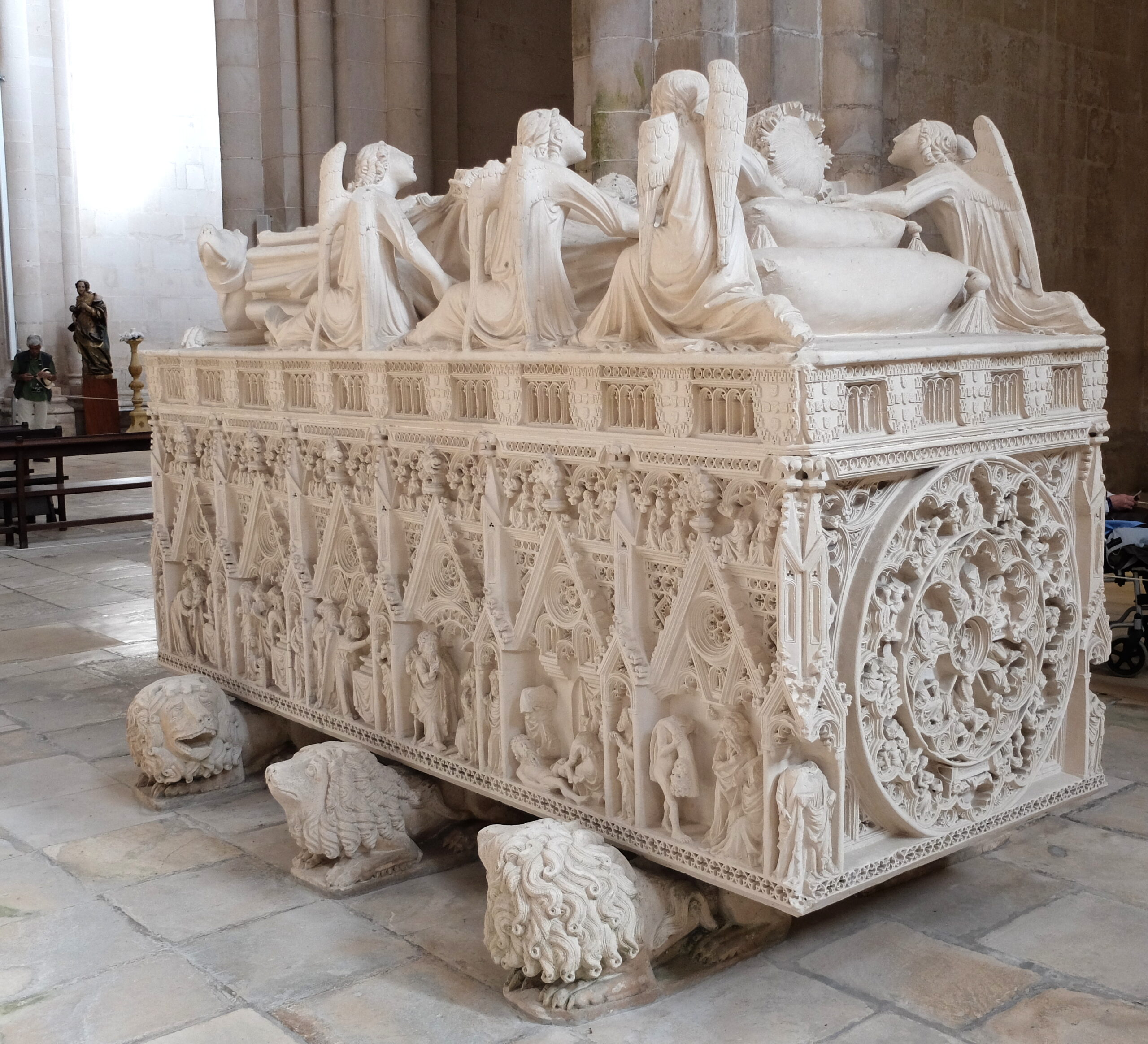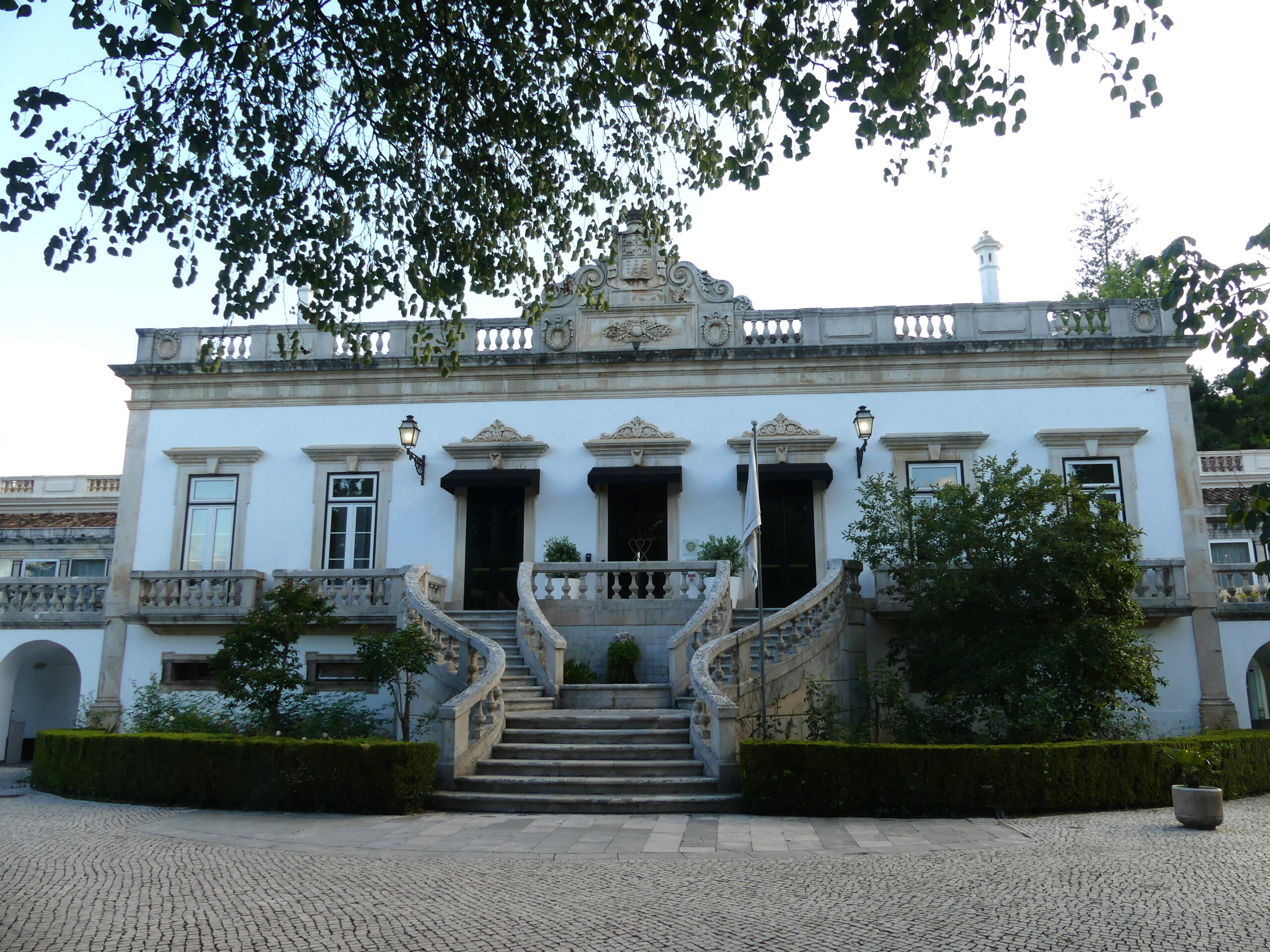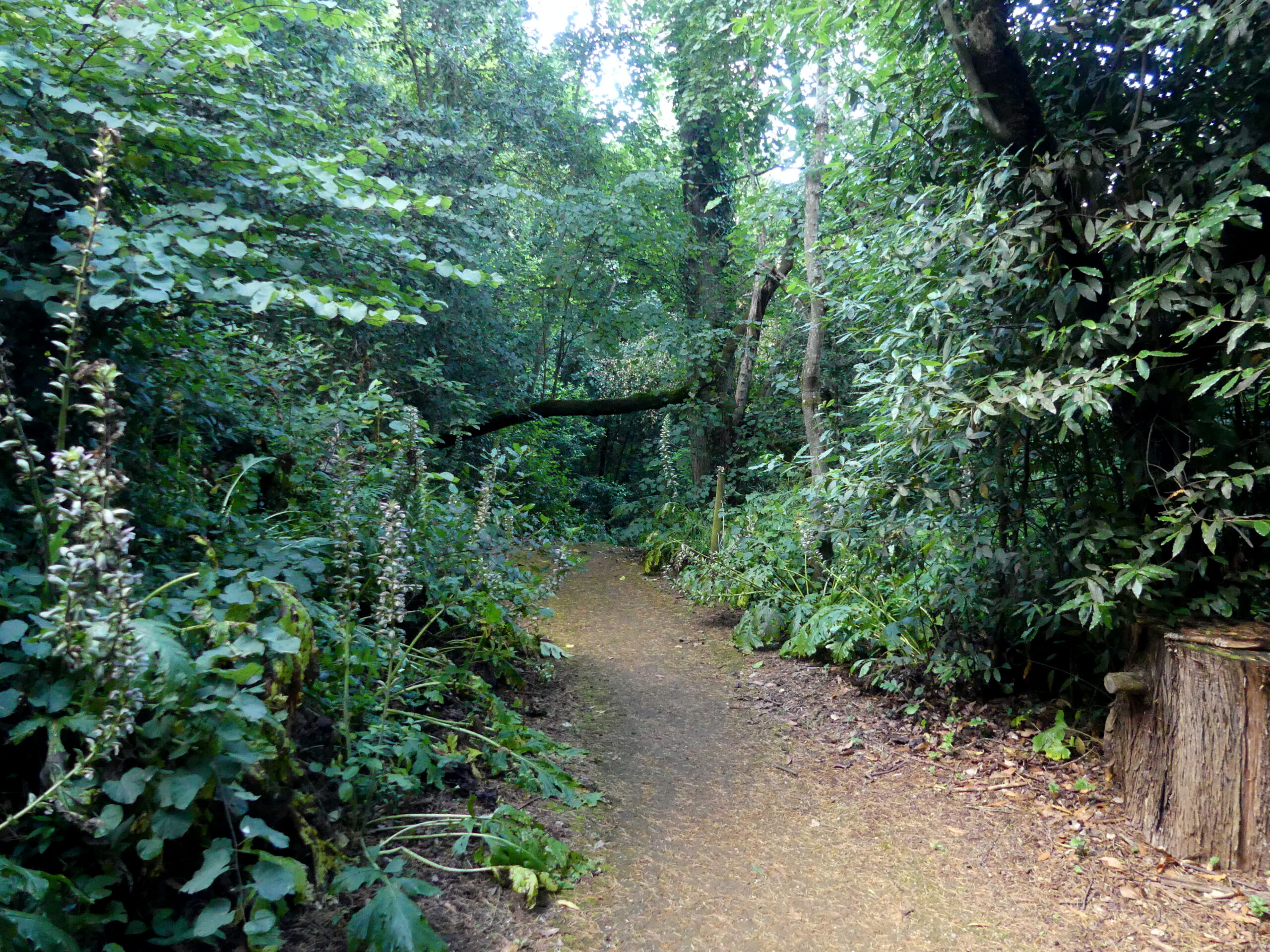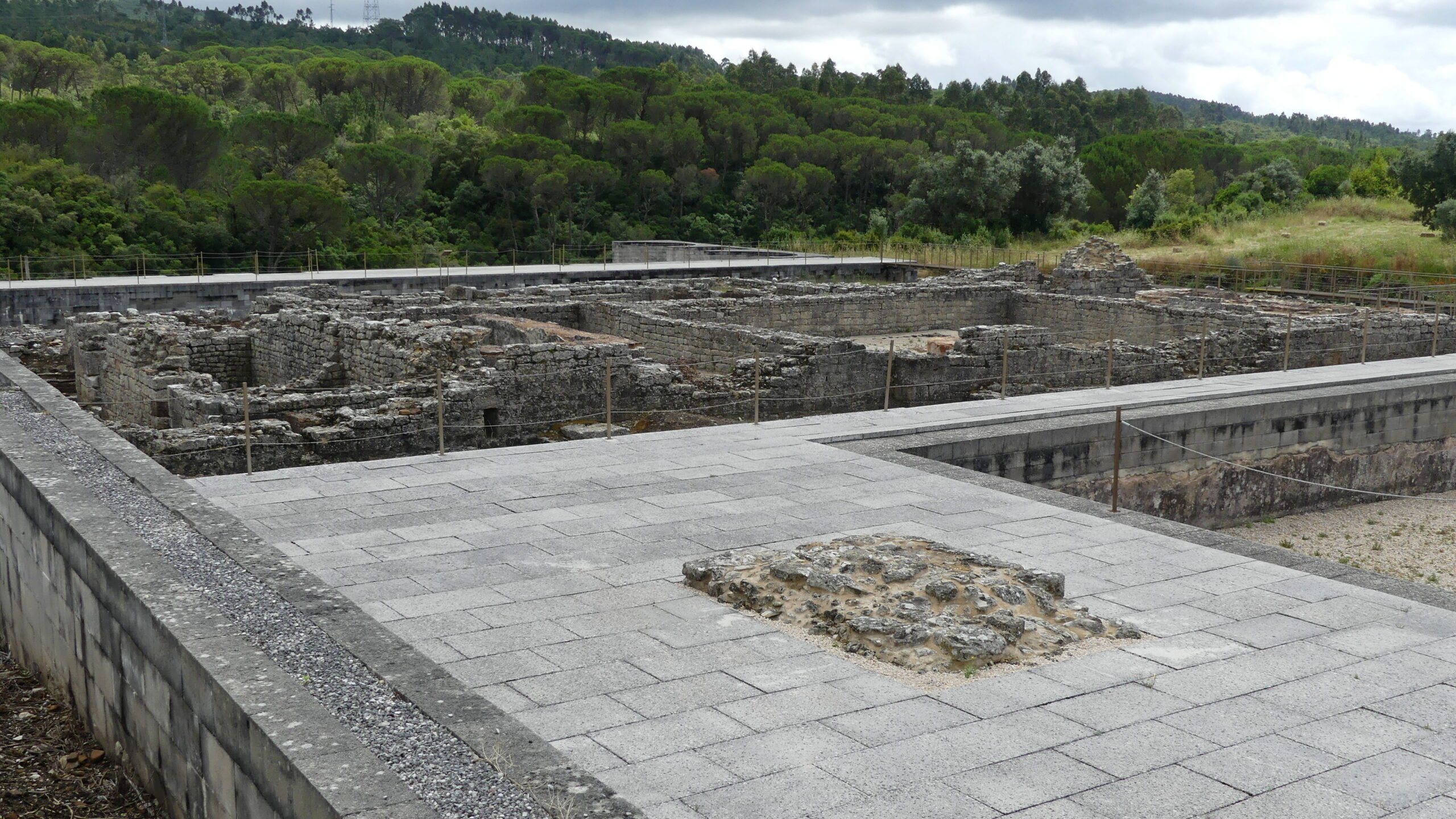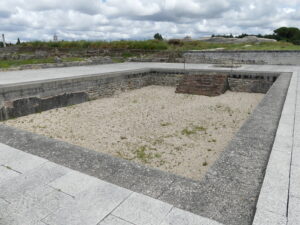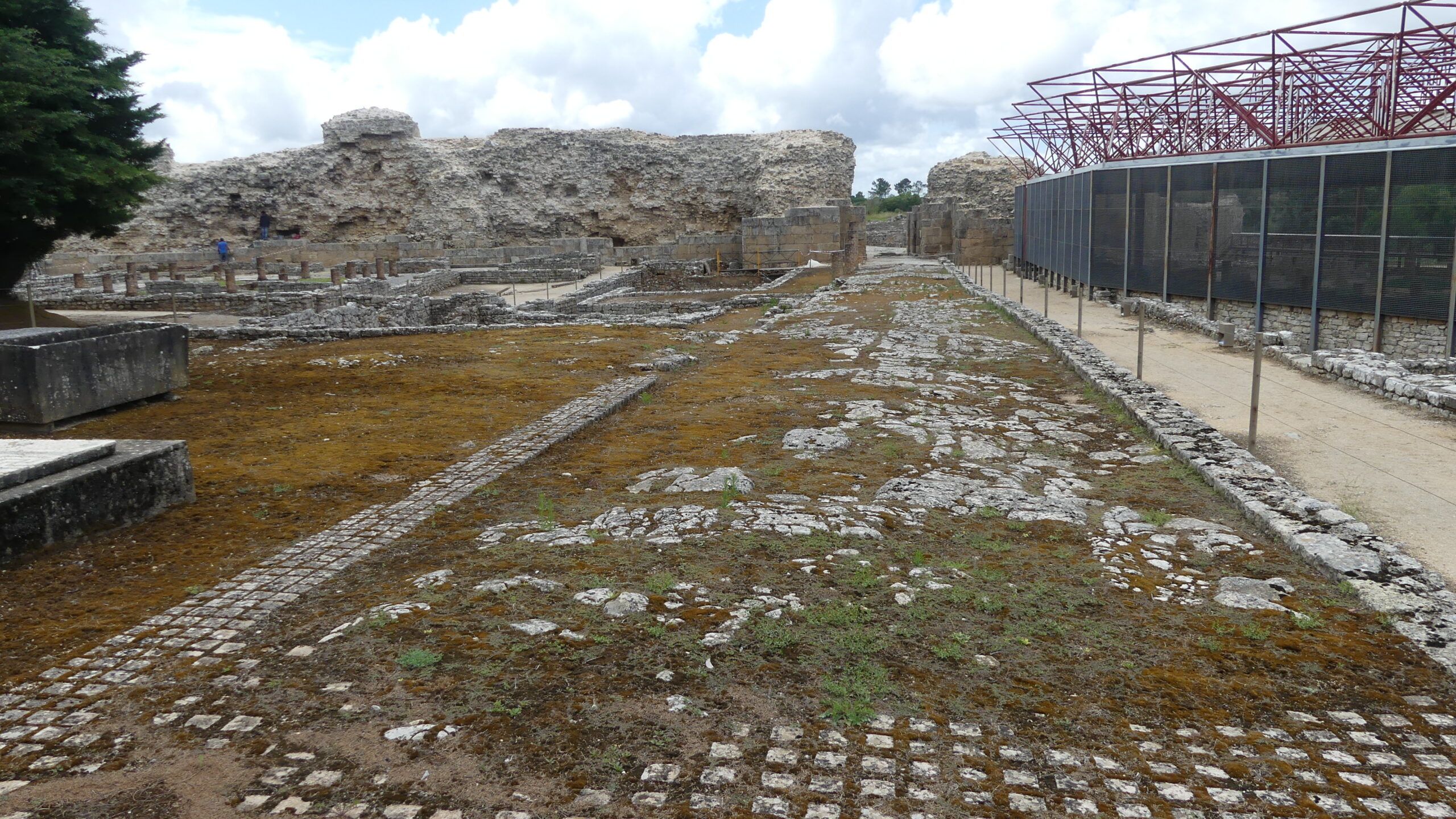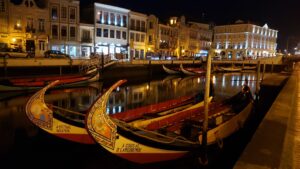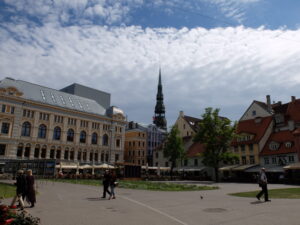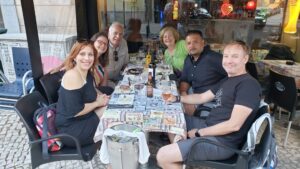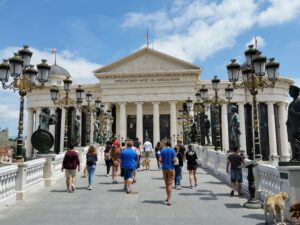In brief: A river, a love story, and a community spirit flowed into our thoughts from diverse waters around Coimbra.
Water is the source of life and sustenance. Near Coimbra, we encountered other diverting qualities: exploration (kayaking on a river), narrative (a love story starting with a fountain and ending in tears), and community (the baths where Romans gathered).
Exploring and Refreshing on the Mondego
It had been two years since we toured on water, an experience we both love. So when we learned about the best river for kayaking in Portugal, we seized the chance. So, one lovely day, we spent four hours on the Mondego’s cool, quiet waters slowly winding beneath forested hills, past sandy banks, and over a few small dams. Those meant a bit more work, some quick portages to go past.
Here we approached a bit of faster water, which seems like a drop-off, an infinity pool.
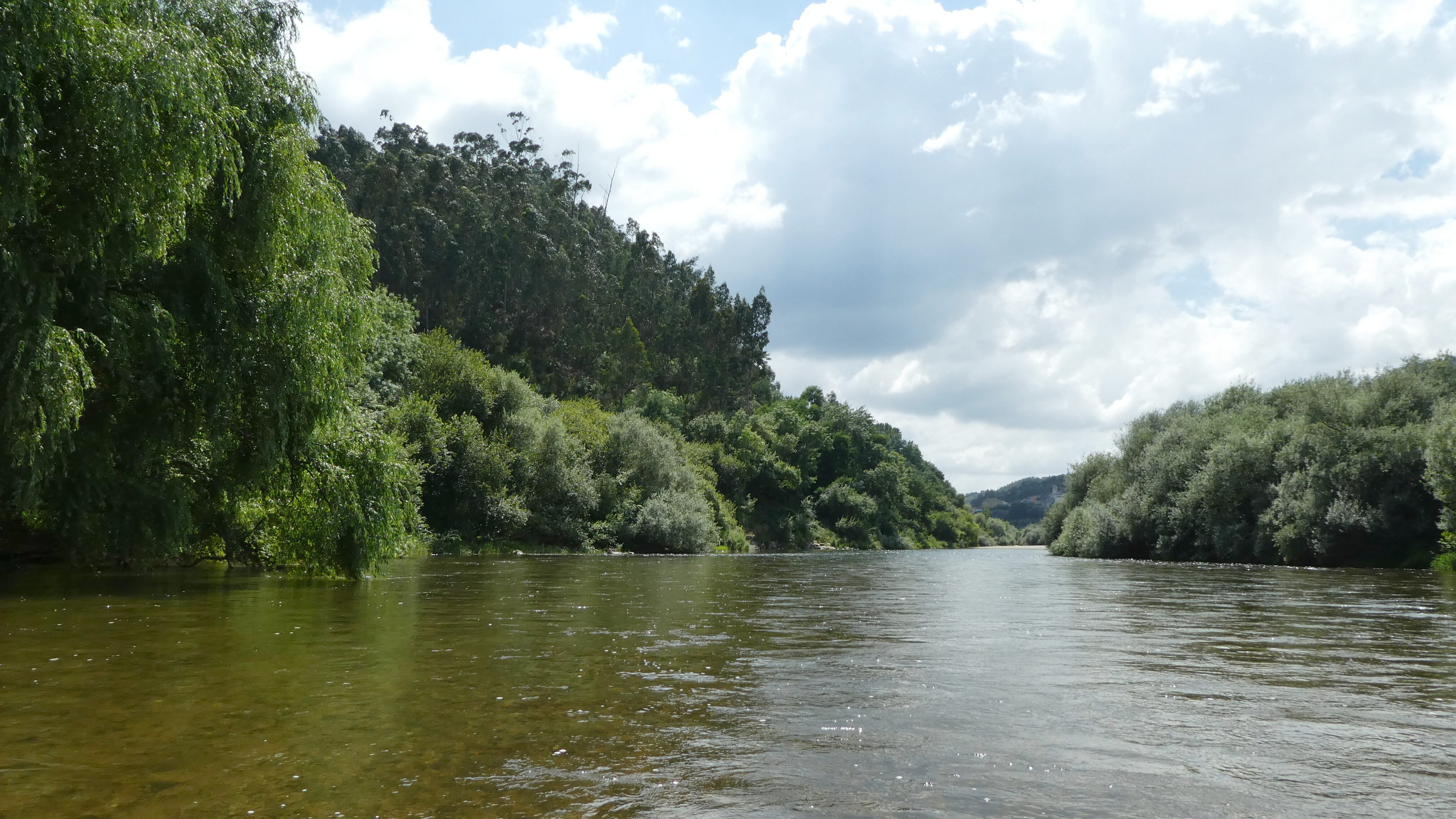
We tried out our new safari/kayaking hats so we could soak up nature without soaking up too much sun.
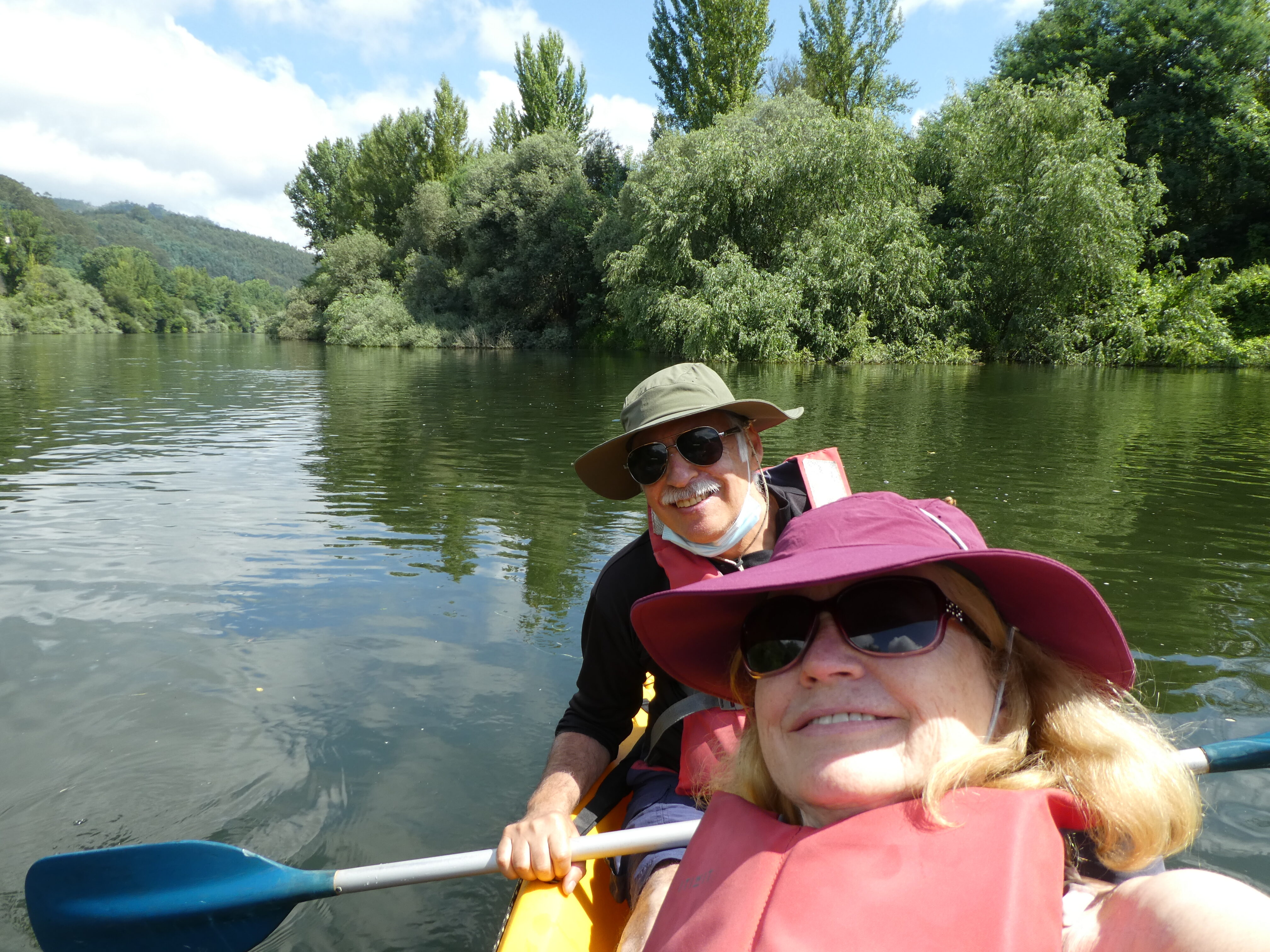
One stopping point along the way where we could swim – staying in place against the steady current.
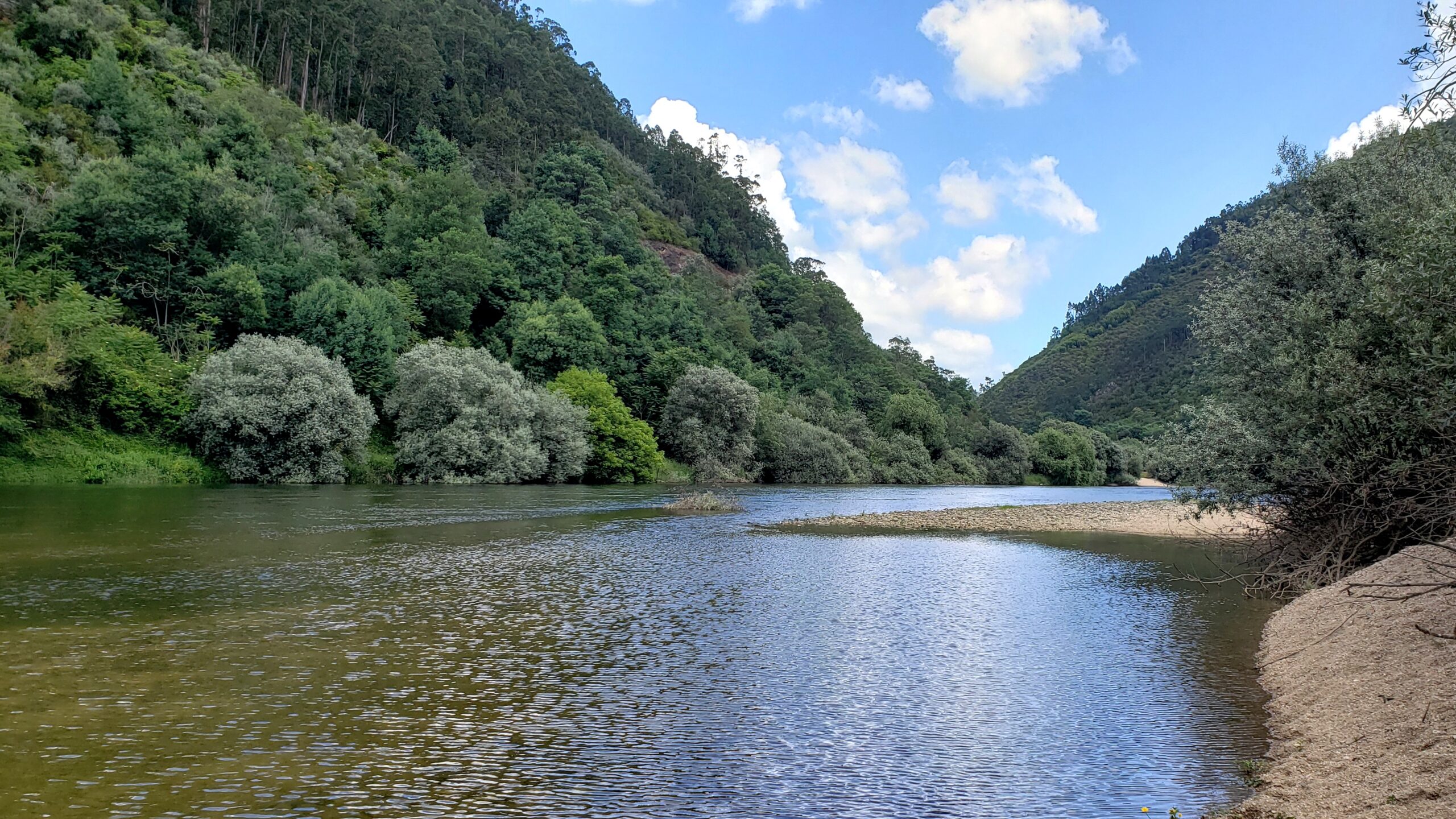
Even our toes feel freer out on the river.
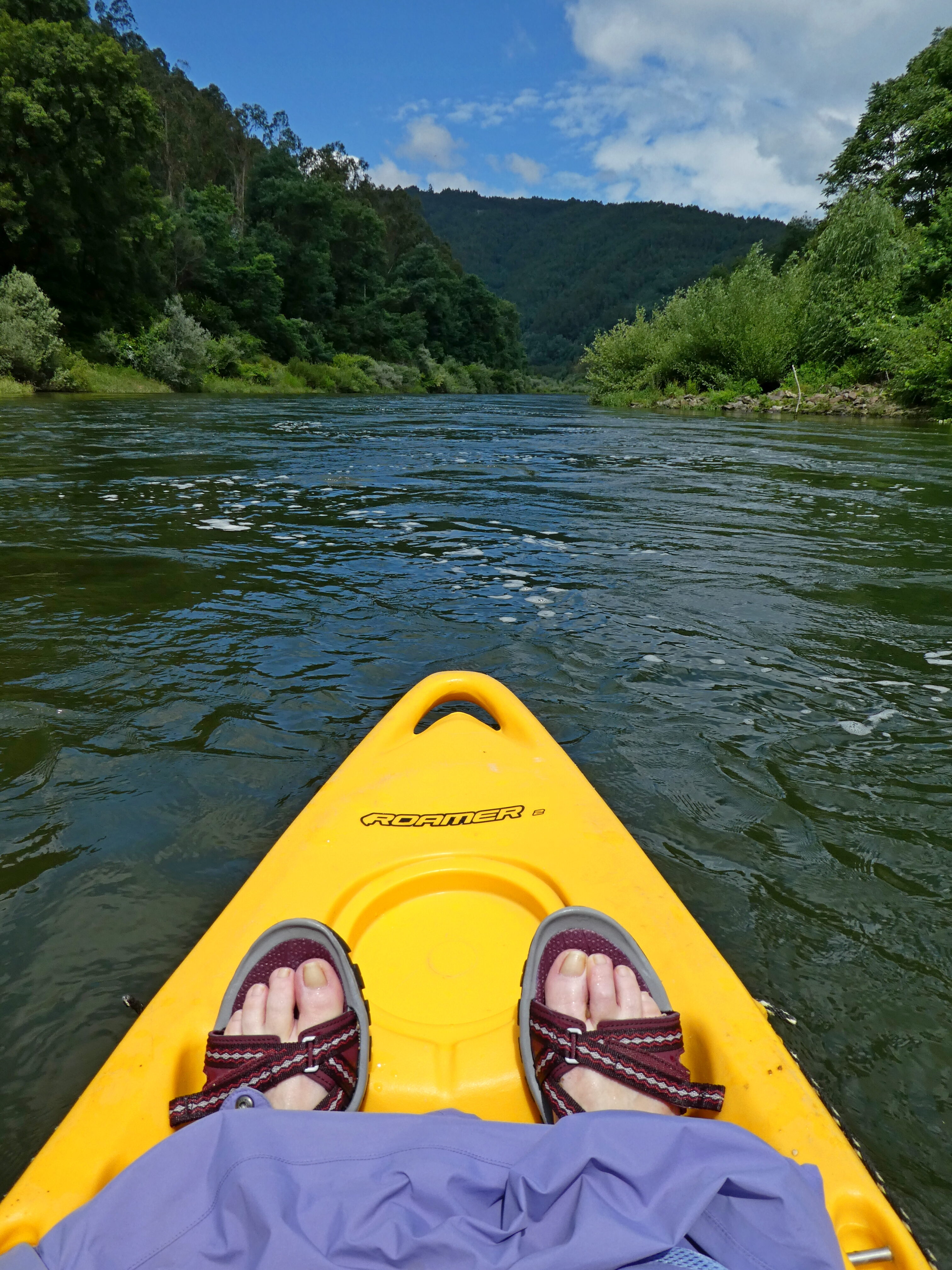
Nancy shows how much we loved this landscape from the water
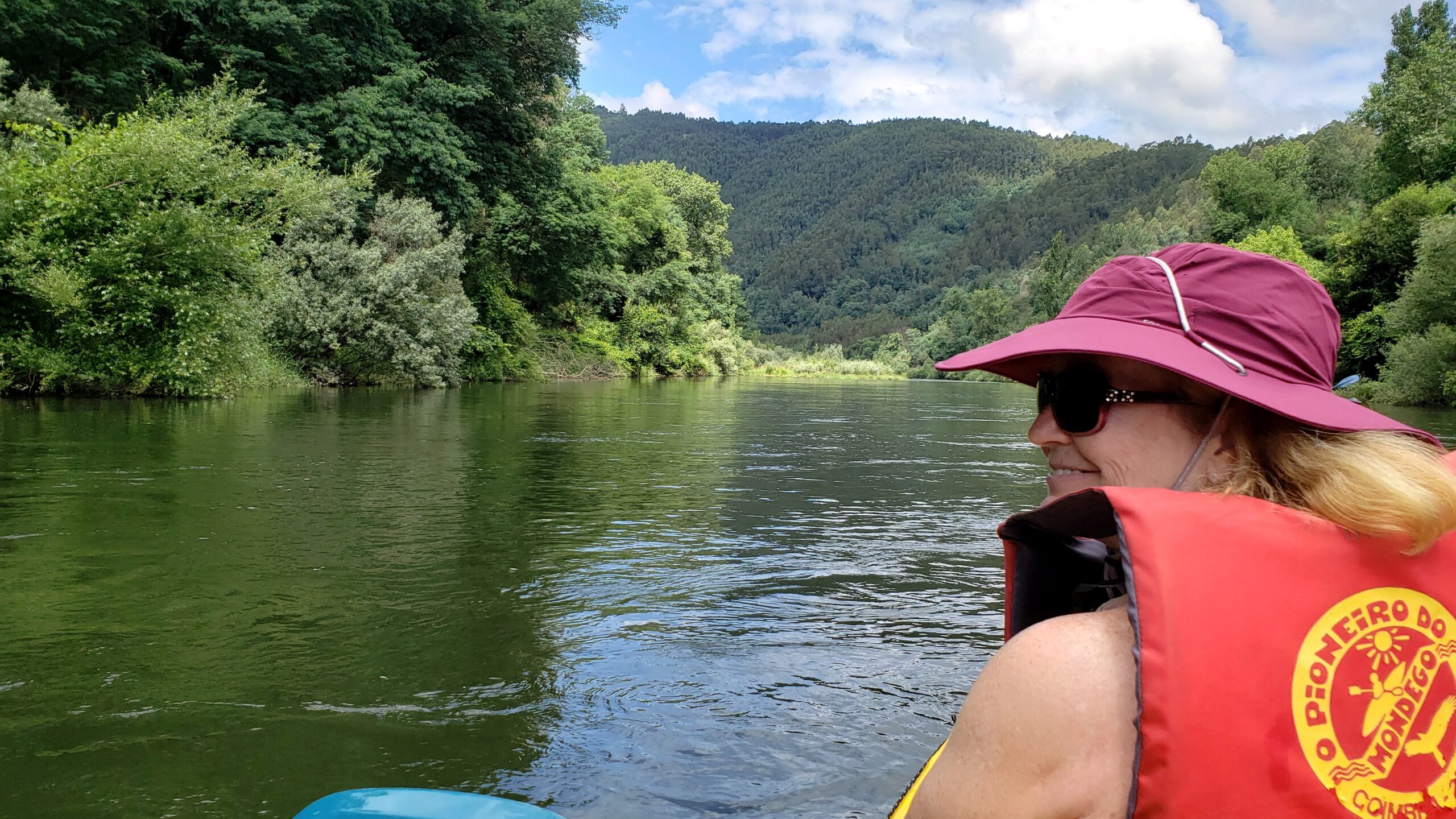
Later, the river broadens as it flows through the university town of Coimbra, but we were content to finish our trip outside amid nature.
It was great to be back.
The Fount of a Tearful Love Story at Quinta das Lágrimas
We couldn’t resist the temptation…the temptation to stay at the site of a world-renowned love story. In the 14th century, Prince Pedro could not resist temptation either. At Quinta das Lágrimas in Coimbra, he met regularly with his beloved Inez, a Spanish attendant to his wife. It was an affair fraught with political threats to Pedro’s father Afonso IV, especially after Pedro’s wife died and the Spanish Inez could become queen. King Afonso soon ordered Inez killed by three assassins, and the tears flowed. After Pedro was crowned king, however, he ensured that the assassins were brutally executed. Pedro then honored Inez by making her queen even in death, and arranging their eternal burial together in elaborate tombs at Alcobaça monastery.
Here is the setting, today, looking across that same Mondego River toward the Quinta from the university sector of Coimbra. But somewhere in the greenery you can find the old hunting grounds that have become the starry hotel of the villa as well as the Convento de Santa Clara, where Inez stayed before her murder.
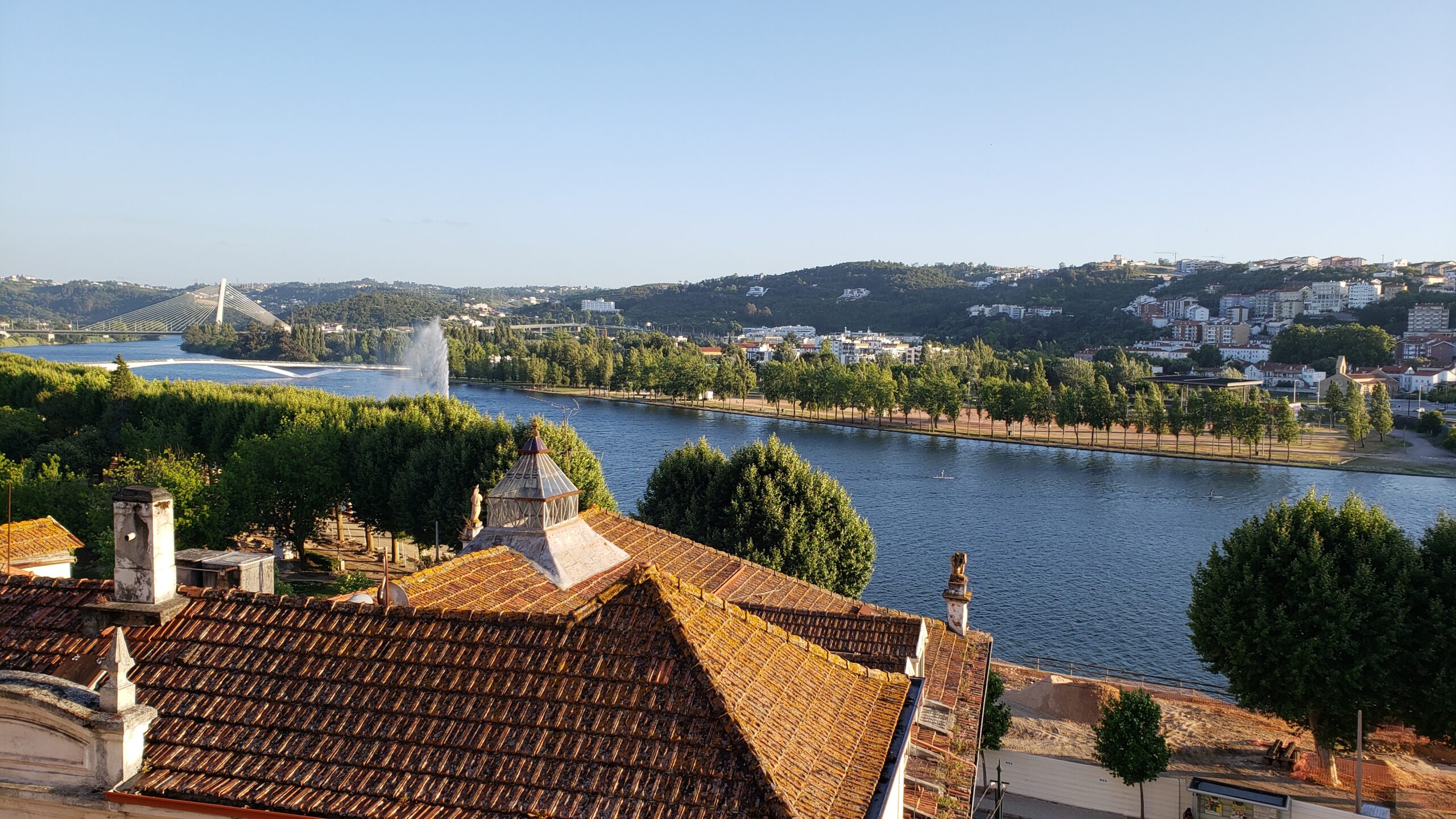
The Fountain of Tears, the location where Inez was killed, flows into a large rectangular pond now. Her blood – it is said – stained the stones and even the water eternally red, but we couldn’t see any color. Here also one imagines that Pedro wept for her loss.
Much, much later, the Duke of Wellington stayed at the farm during his defense of Portugal against Napoleon. He so adored these grounds and the lover’s tragic story that he mounted a commemorative plaque at the site. It was inscribed with this mournful tribute to Inez by the 16th century poet Luis Camões in his epic, The Lusiadas:
Nor less the wood-nymphs of Mondego’s groves
Bewail’d the memory of her hapless loves:
Her griefs they wept, and, to a plaintive rill
Transform’d their tears, which weeps and murmurs still.
To give immortal pity to her woe
They taught the riv’let through her bowers to flow,
And still, through violet-beds, the fountain pours
Its plaintive wailing, and is named Amours.
We shared a moment at the remnants of a medieval building where those other lovers may have met.
Nearby is the Fountain of Love (or Amores in the other quote from Camões). From here Pedro supposedly launched letters in tiny love boats that descended a channel to the convent where Inez stayed.
Camões writes of their entwined emotions:
By night his slumbers bring thee to his arms,
By day his thoughts still wander o’er thy charms:
By night, by day, each thought thy loves employ,
Each thought the memory, or the hope, of joy.
Four years earlier, we had first learned of the tale of Pedro and Inez when we found their adjacent tombs at the monastery of Alcobaça. Here, King Pedro wanted the two of them to lie together for eternity. This is Pedro’s elaborate crypt, topped by attendant angels, in a splendor equally matched by Inez’s. At the end is a representation of a medieval meme, the wheel of fortune: one moment you’re up and the next you’re down. In his turbulent story and his love for Inez, Pedro must have felt how that wheel turned for him.
The main building of today’s villa at Quinta das Lágrimas hotel is the result of a 20th century rehab in a neo-baroque style.
The grounds of the Quinta offer some appealing walks along its hillsides and valleys, where diverse and sizable trees abound, though largely planted in the 19th century to build up the forest.
One of the winding trails through the property at the Quinta. We spent an enjoyable hour or two wandering about its thick woods in the waning light, despite some sections made muddy and slippery by recent rain. At times, the woodland trails were thickly overgrown and dark with spindly trees, creating a sombre atmosphere quite fitting for the tragic tale.
In the time of Pedro and Inez, the land was hunting terrain for the aristocracy. More recently, a large chunk of it was converted to a golf course.
Here we could sit and enjoy the entangled roots of this massive fig tree. Elsewhere, two sequoias still growing in these woods were donated by the Duke of Wellington.
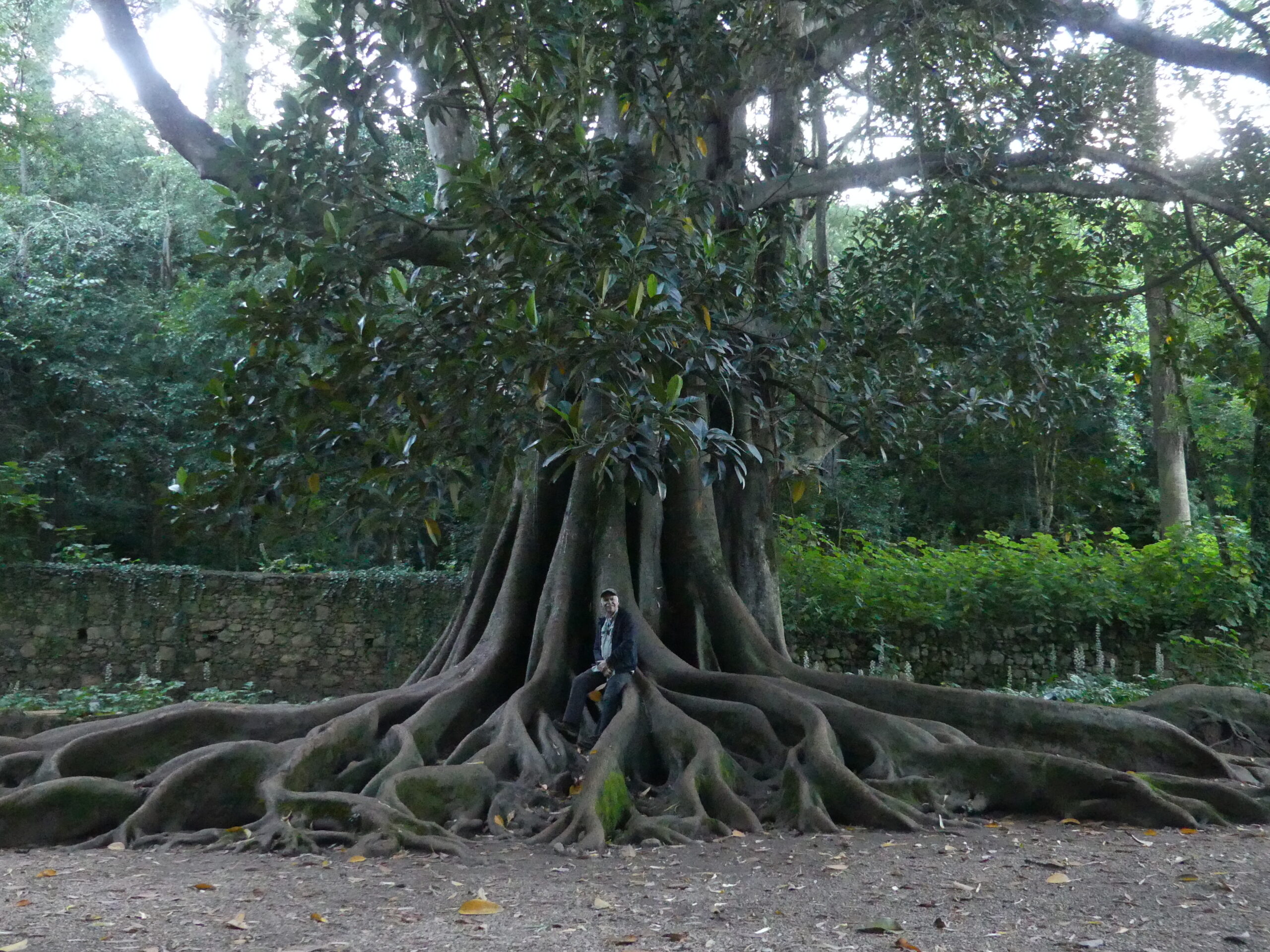
Touring the villa is a treat as well. In the old building, this wood-paneled library glowed with an enticing charm. Near the library sits the simple chapel that served the villa.
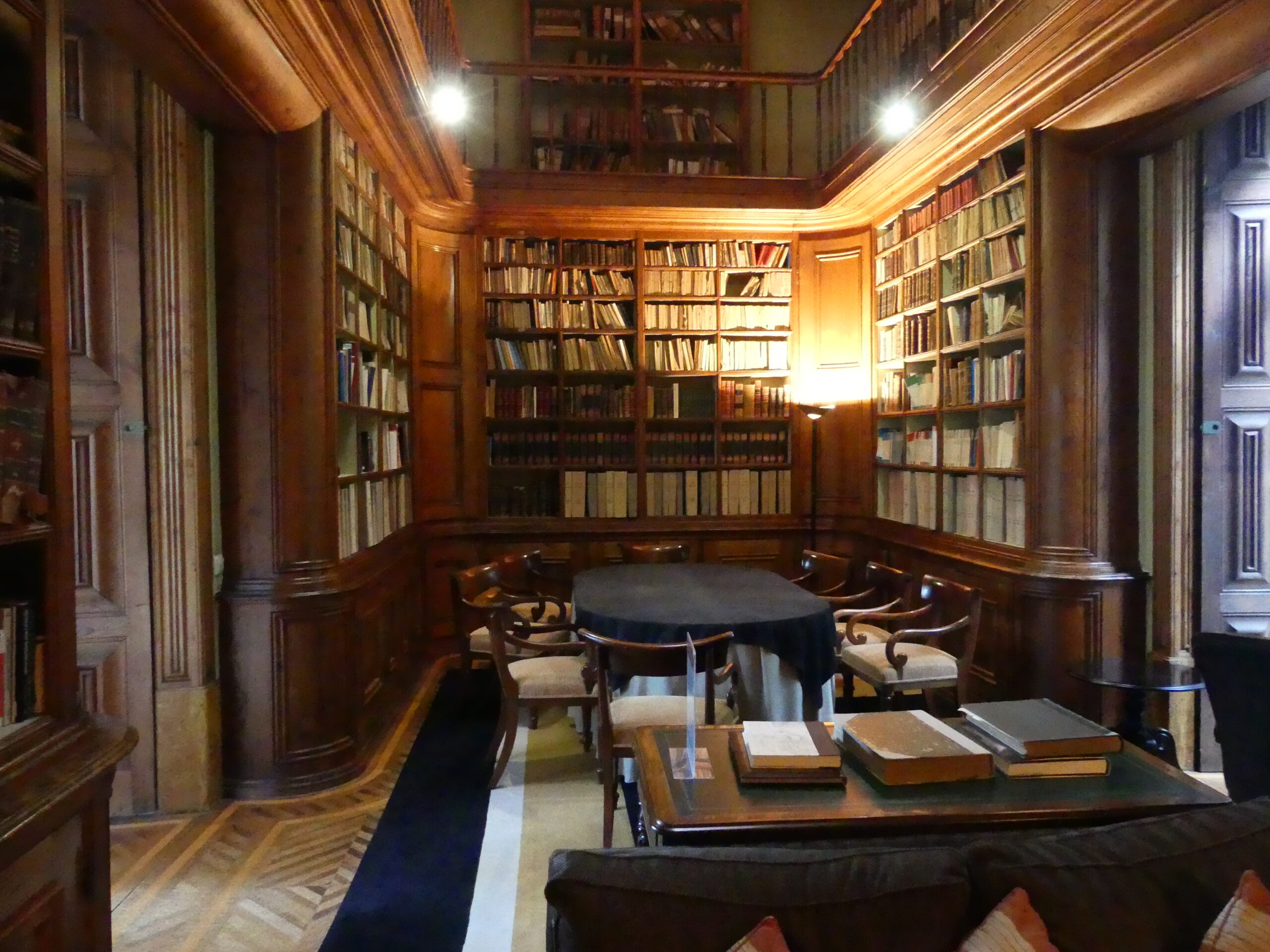
Oddly, the most sizable set of items here in the library were collections of the magazine Paris Match. The Duke would likely not have approved.
A Plethora of Baths (and Villas) at Roman Conimbriga
Only a tenth of the old Roman town of Conimbriga has been unearthed, some 15 kilometers from the university town of Coimbra. Many other Roman towns in Portugal were grander. But this is the richest Roman site now for what has been revealed or reimagined by archeologists – the central courtyards and stunning mosaic floors of grand villas, the temples and defensive walls, as well as the watery bits: the centers for communal bathing, the aqueducts and fountains. We loved it all.
From what remains here, you could easily guess that cleaning yourself with your friends was the principal activity of this settlement, which numbered 10,000 at its peak. Three bath complexes occupy a huge area within the town. This southern one was the largest. It included a sizable swimming pool in the near right.
Beyond that you could enjoy a typical Roman array of cleansing or relaxing spa rooms in various temperatures delivered through a sophisticated underground water flow.
Then, beyond that, with a view over a verdant valley, you could opt for physical exercise in the open gym of an even larger space, the palestra.
The swimming pool of the southern bath still shows off original stonework and stairs, though likely reconstructed by archeologists.
You could have a very large pool party in this one, after a good rain anyway.
Below is the entrance to the old municipium of Conimbriga. That’s its main road heading from near to far, where a gate in the walls opens up. You can find ruts in the stone road where chariot and cart wheels wore the surface down. The wall was hastily built in the 4th or 5th century to keep out invading non-Romans, a kind of urban renewal project that destroyed a lot of homes and one of the baths.
To the left are the remnants of a number of large villas with their magnificent mosaic flooring still surprisingly intact.
To the right is a protective structure over the charming House of the Fountains, whose mosaic floors include animals and human figures within geometric adornment.
In contrast to the communal spirit of the baths, the villas brought us into the more private space of the Roman era dwellers at Conimbriga.
The House of the Fountains features a reconstruction of a central garden courtyard, as it might have been, complete with fountains and pools. But its real treasures are the mosaic floors, which use geometrical elements to complement a diverse multitude of animals, figures, and deities. Here is a particularly gruesome example of a warrior feeding a wide-eyed head to a mer-dog. No, we have no idea why.
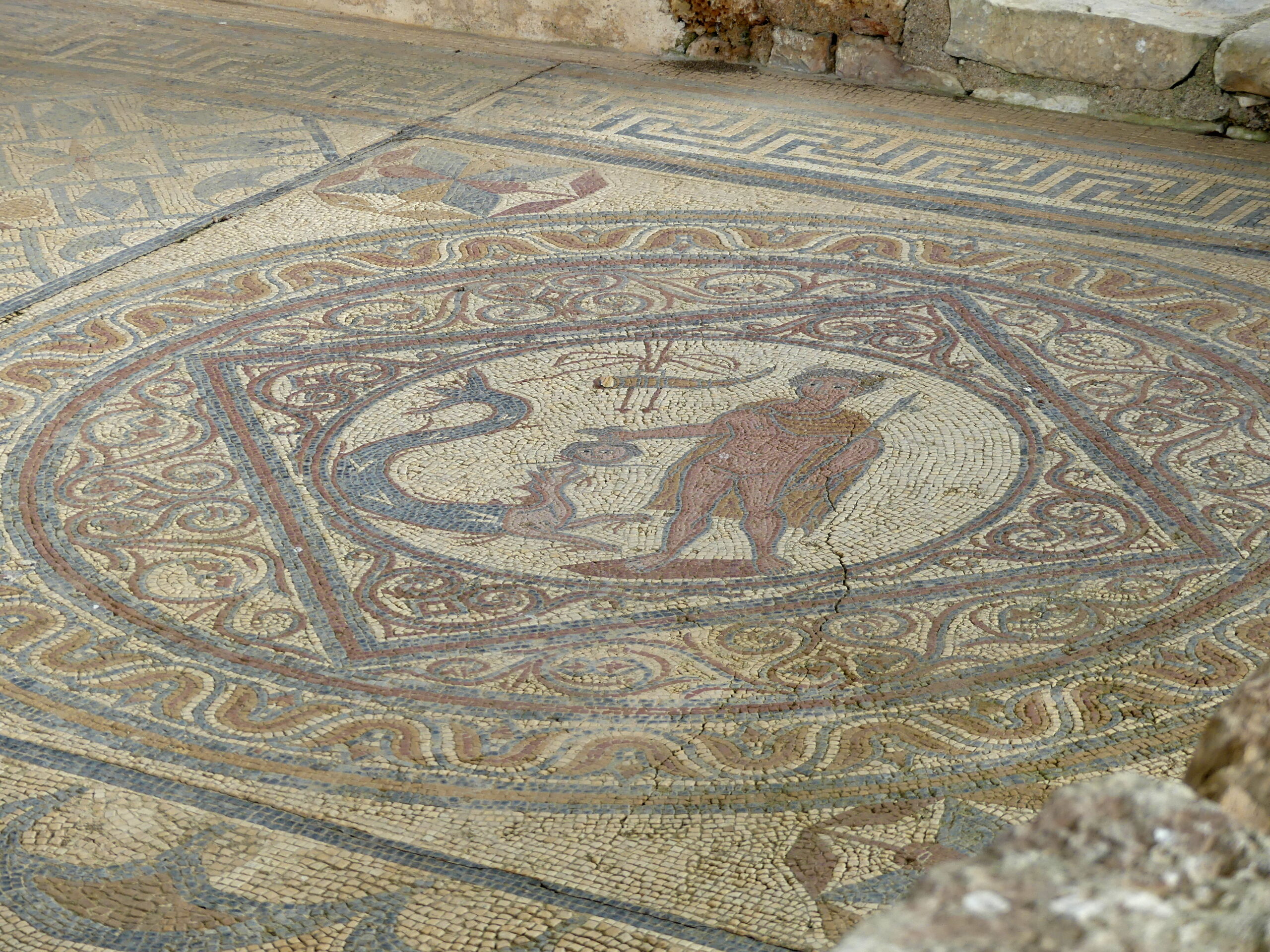
A typical inner courtyard – completely ringed by sumptuous mosaic flooring – marks the location of another villa near the defensive wall.
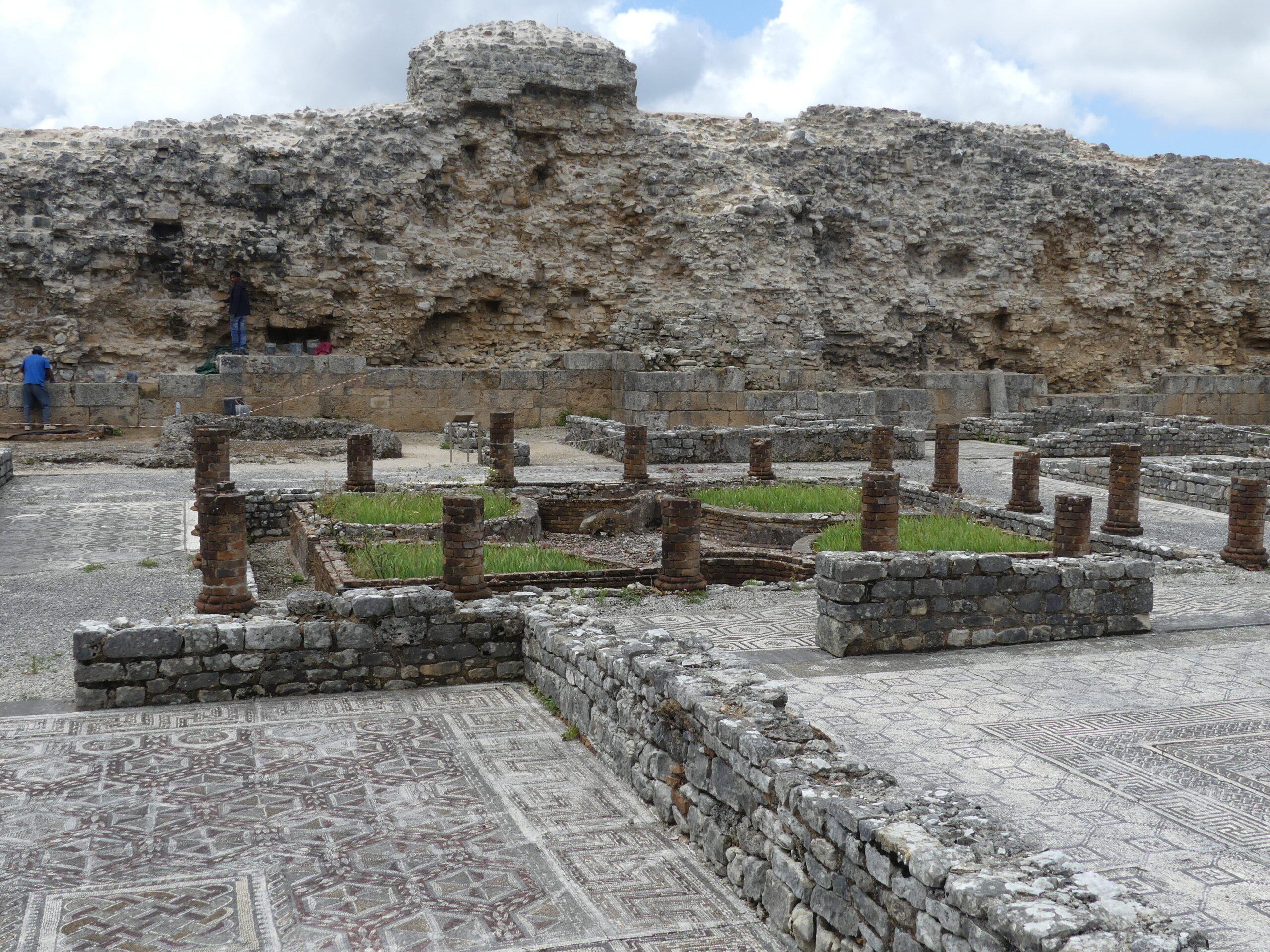
Here is another of the splendid mosaic tile floors, with an intricate, mesmerizing geometric pattern – meant to walk all over. This villa was also in the older part of town, divided from the rest by that massive defensive wall.
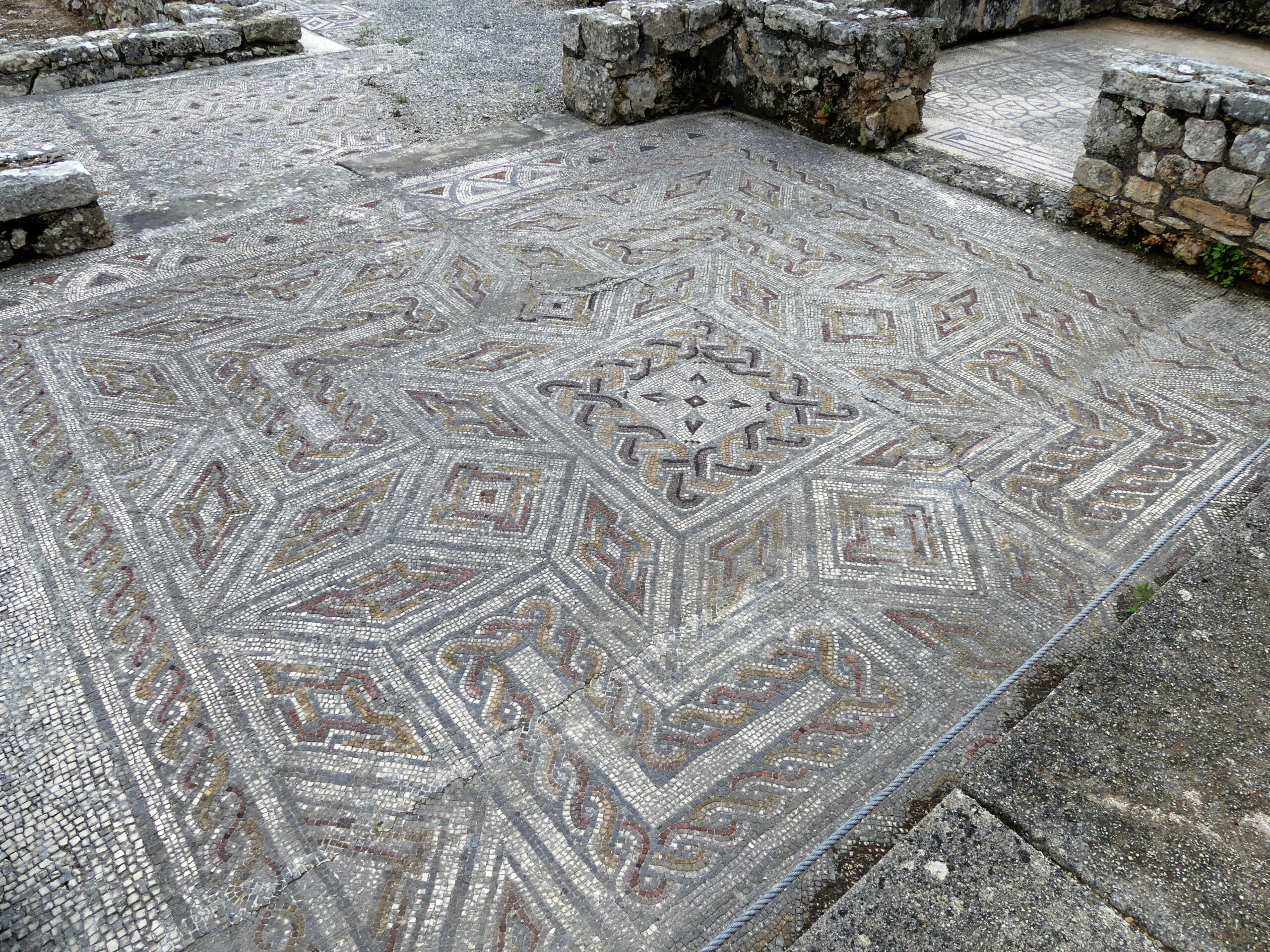
Piano bar? This was to us the best of the geometric mosaics, with an intricate pattern that could make you dizzy with too much attention.
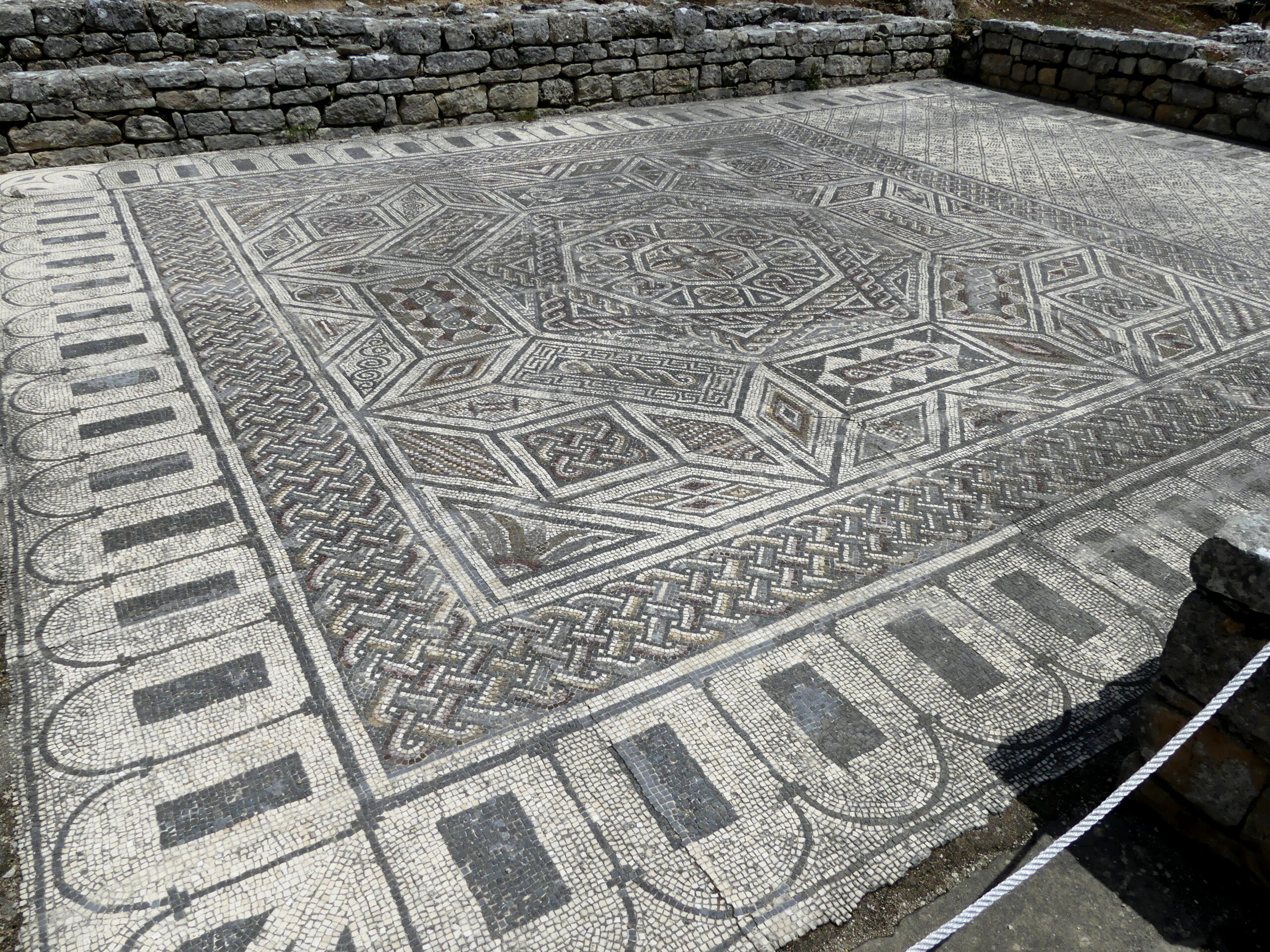
Another superb geometric mosaic preserved from one of the villas near the defensive wall.
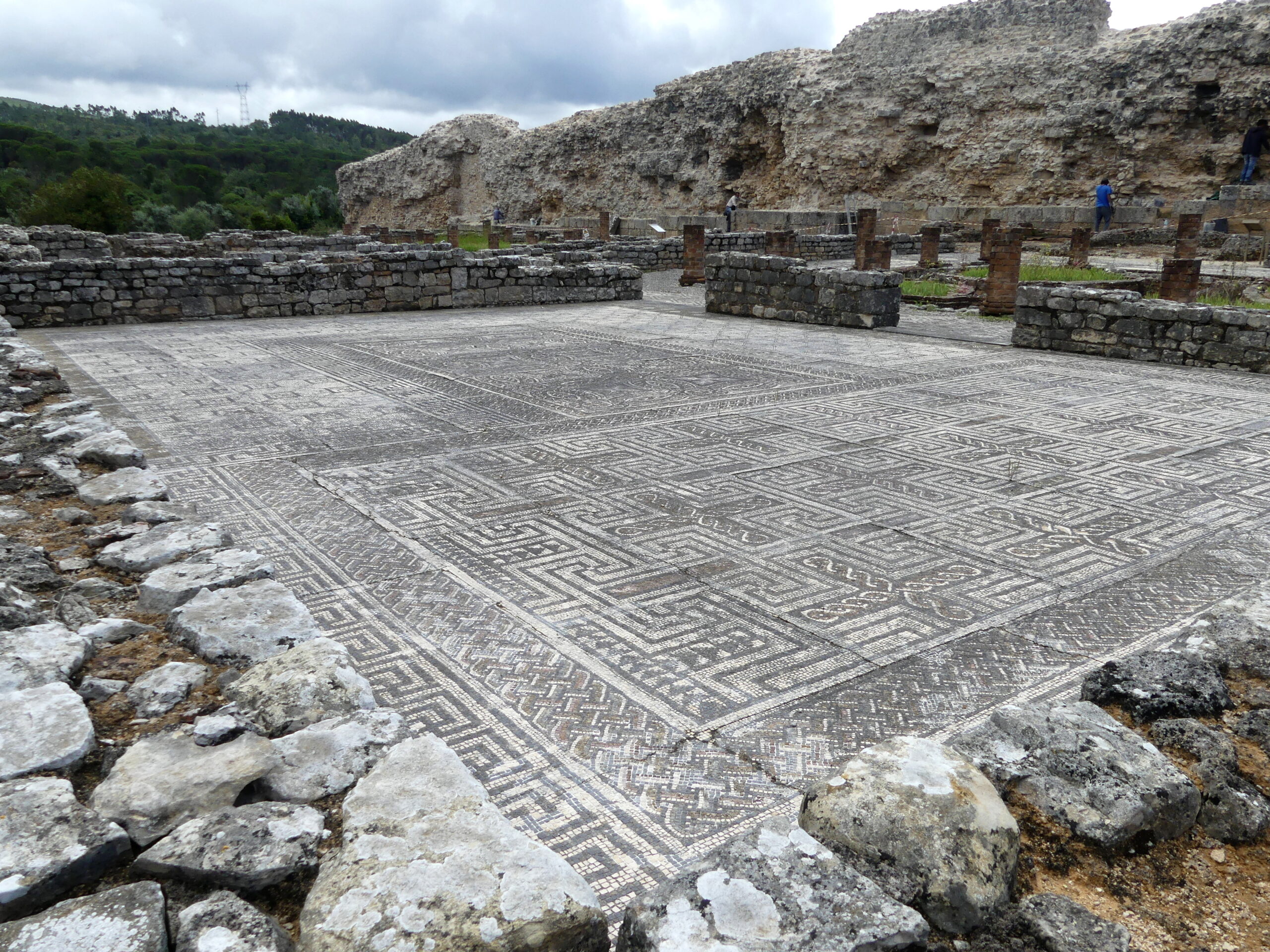
South of the wall some very wealthy people lived. This courtyard of the “Cantaber” house, with its pillars constructed of bricks in the form of the arcs of a circle, splendidly accommodated its residents in 40 rooms and nearly 3300 sq. meters (over 35000 sq. feet) from the 1st to the 5th century AD. You can see the outline of the garden courtyard and water features that were typical of Roman villas.
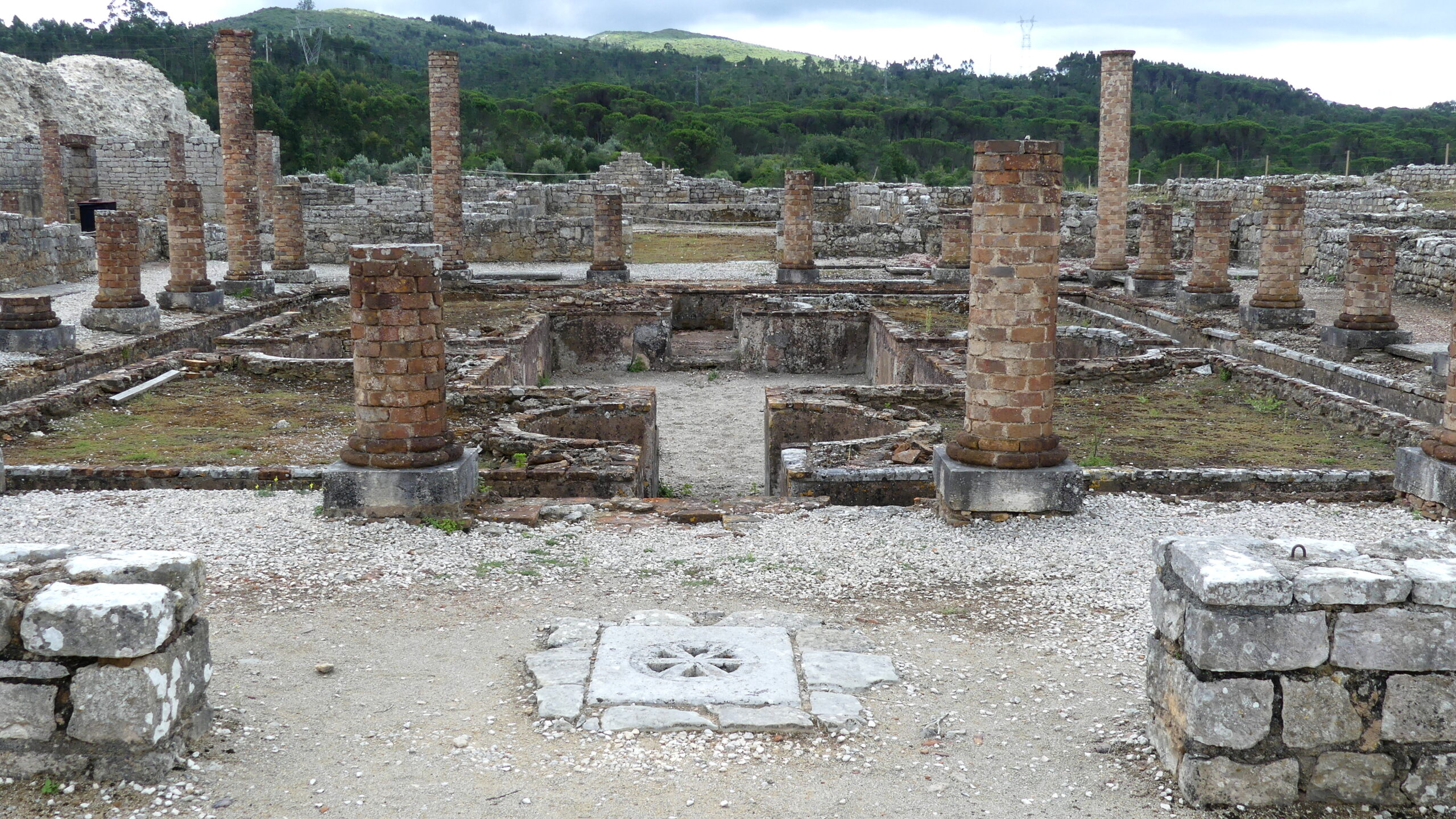
In the museum at Conimbriga, various displays show off everyday items unearthed at the site – including this artful assemblage of pots – but also tools, glassware, brass fixtures, religious stele, and so on. Archeologists also found and displayed many potent totems to ward off evil spirits, often in the shape of phalluses.
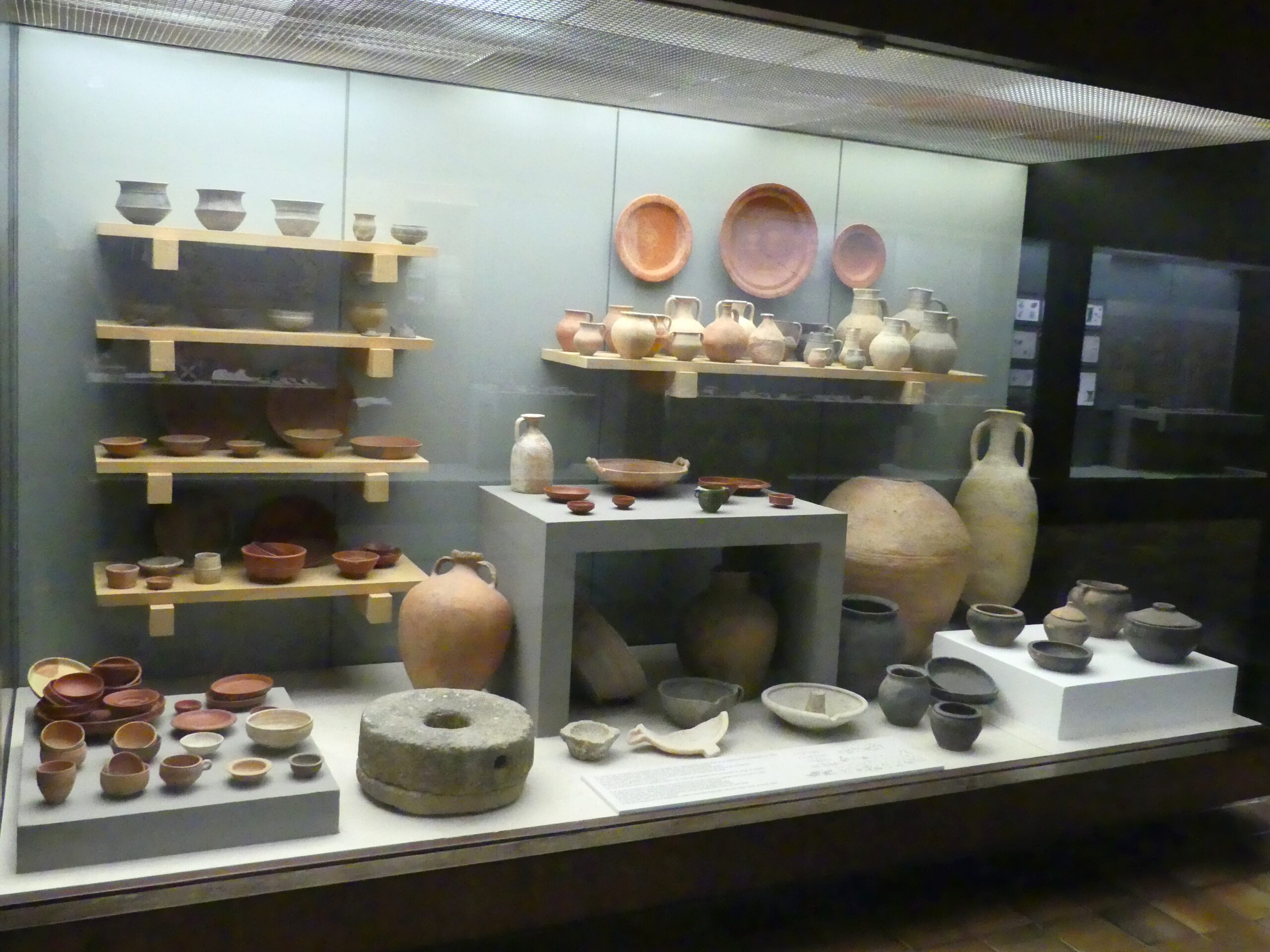
Playtime. This display at the museum shows a number of items used for games in the Roman town – playing boards and pieces are on the left; dice and chess-like pieces at the top; and 2000 year old flutes and whistles are displayed on the bottom right.
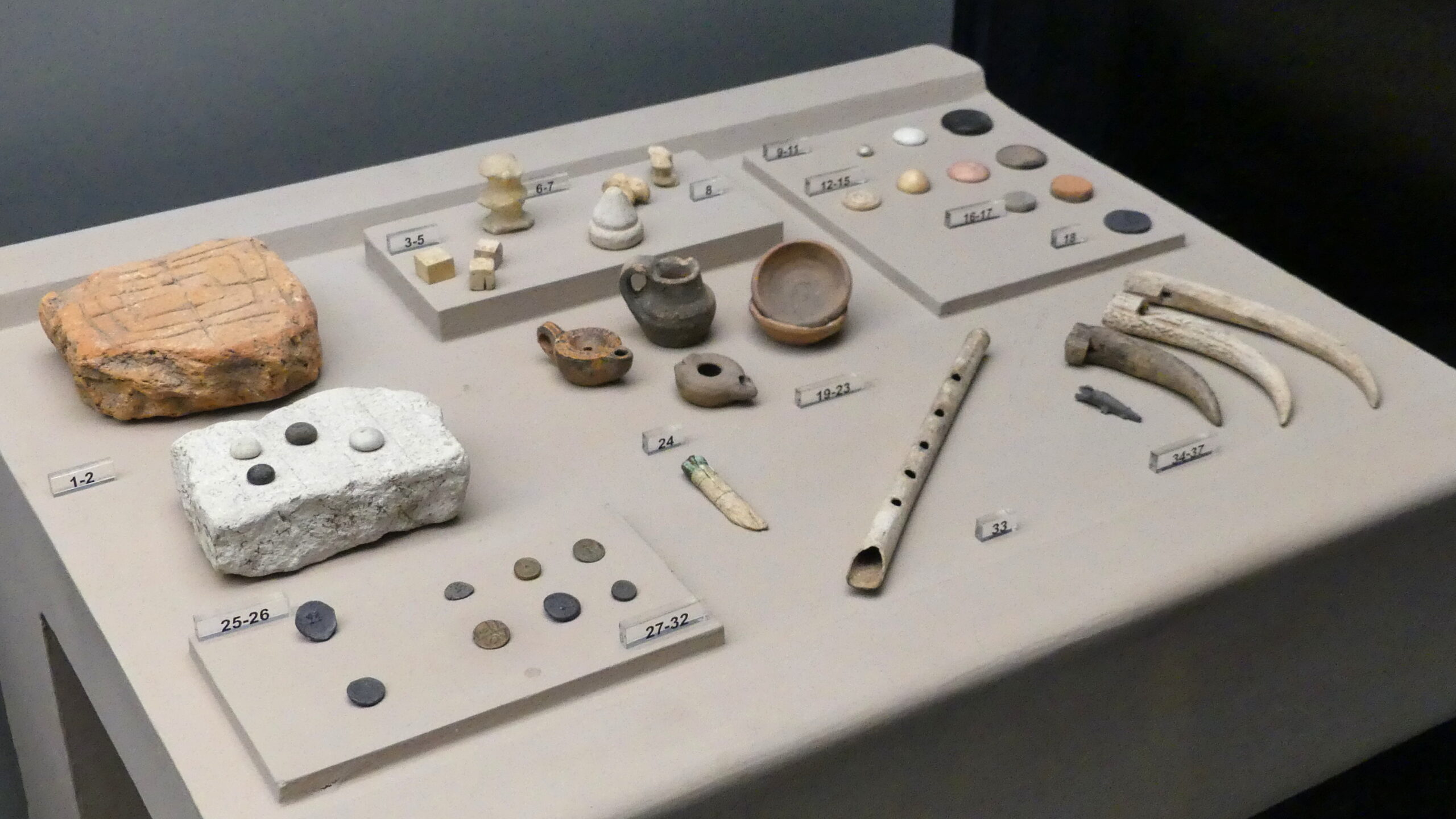
Most of the Roman forum and the temple within it are reconstructions, with a few original columns and walls. These stone huts, discovered below the forum, don’t look like much. But they are remnants of housing occupied by a pre-Roman civilization that lived on this site for hundreds of years before Rome imposed its priorities. You can even detect a local street running through the old town.
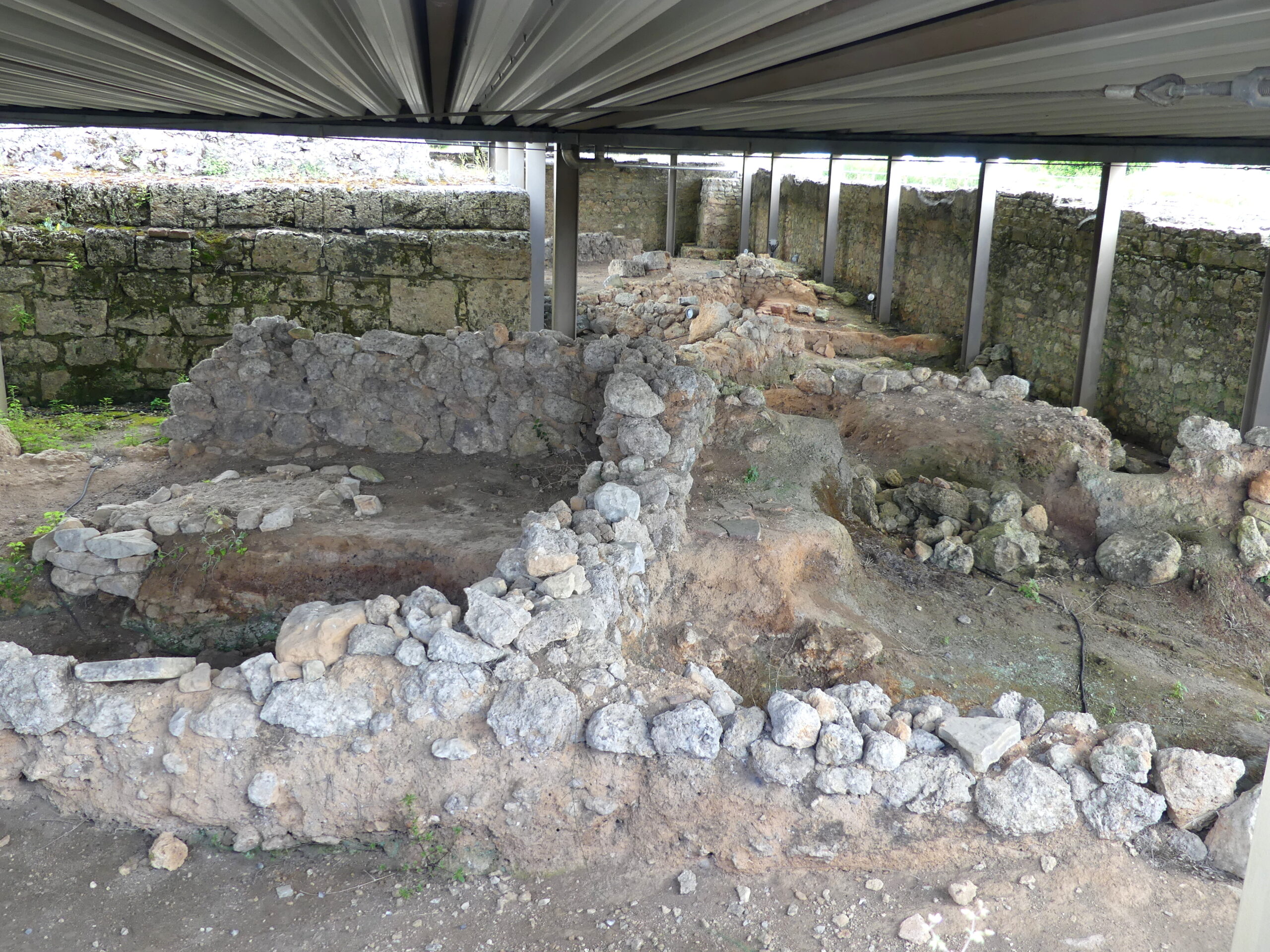
Though the baths were impressive in size and number, ultimately it was the ripple of the mosaic designs that flowed through our memories.
(To enlarge any picture above, click on it. Also, for more pictures from Portugal, CLICK HERE to view the slideshow at the end of the itinerary page.)


